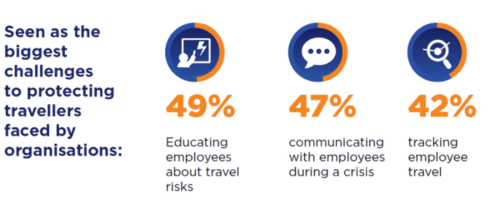3 Top tips to improve resilience
• Education about travel risks
• Communication during a crisis
• Tracking travellers
These findings show us what is pre-occupying managers. They also indicate something else: managers are in danger of being drawn into a very low level of detail that could be addressed more efficiently: time spent tracking people down and trying to communicate could be reduced in order to make additional time for addressing the bigger picture.

How do you save the time you’re losing?
It all comes down to something that may be commonly known but is often overlooked: putting in place an optimum Business Continuity Plan for resilience in a crisis:
Business Continuity Planning can be complex, so the effort of building and maintaining it can be daunting, but is essential: looking after your people, managing client relationships, and not just protecting your reputation, but enhancing it by embodying good practice. There are some simple steps that any organisation can take.

3 Top Tips to Improve Resilience
1. Think ahead: How will you respond?
- Think through likely scenarios – you probably have previous experience you can draw on. What was best practice? What are the likely pitfalls? What happens if you or your immediate team are unavailable?
- Educate your managers on what they need to do – remind people of the role they need to play. Protecting your workforce is everyone’s responsibility, but you cannot assume people will take this on intuitively. Spend time creating awareness and support so your managers feel a sense of ownership. That gives you more help to draw on; and if your people have a duty of loyalty, they will help you too.
2. During an incident: Automate, automate, automate
- Set up a system that will alert your people – make sure you have a traveller tracking tool in place that will do the bulk of the work for you. You should also think about how and when you will get a message out to your whole organisation.
- Work out how you will check your people are okay – it is essential to have this linked to your traveller tracking tool, to ease the overall management of what’s happening. Ideally you will get the message out through two way communication to improve the response rate.
- Have a backup plan in case you can’t manage the crisis alone – even the best organisations may be out of their depth if the worst happens. You will need a solution that can emulate your role if you are not in the office. One option is to nominate alternatives; another is to outsource the checking process completely.
3. The wash up: Template your management reports
- This is simple but very important if you want to show you are in control of the situation. Setting up a simple report template will help you communicate to your leadership and give you both piece of mind. Once again, hooking this into your traveller tracking tool will mean that you can report and communicate in a matter of minutes.
Have flexible response templates, which can be modified quickly in a crisis, from cyber security incidents to national political upheaval.
To find out more about how you can improve your Business Continuity Plans and reduce lost time, please contact us.

 HOW CAN WE HELP?
HOW CAN WE HELP?








